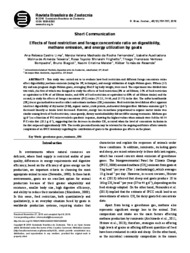Effects of feed restriction and forage: concentrate ratio on digestibility, methane emission, and energy utilization by goats.
Effects of feed restriction and forage: concentrate ratio on digestibility, methane emission, and energy utilization by goats.
Autoria: LIMA, A. R. C.; FERNANDES, M. H. M. R.; TEIXEIRA, I. A. M. A.; FRIGHETTO, R. T. S.; BOMPADRE, T. F. V.; BIAGIOLI, B.; MEISTER, N. C.; RESENDE, K. T. de
Resumo: This study was carried out to to evaluate how feed restriction and different forage:concentrate ratios affect digestibility, methane emission (using the SF6 technique), and energy utilization of Anglo-Nubian goats. Fifteen (15) dry and non-pregnant Anglo Nubian goats, averaging 30±2.9 kg body weight, were used. The experiment was divided into two trials, the first of which was designed to study the effects of feed restriction (0% or ad libitum; 15% of feed restriction or equivalent to 85% of ad libitum intake; and 40% of feed restriction or equivalent to 60% of ad libitum intake) and the second, to study the effects of forage:concentrate (F:C) ratios (75:25, 54:46, and 25:75) in the diet. The sulfur hexafluoride (SF6) tracer gas method was used to collect and estimate methane (CH4) emissions. Feed restriction level did not affect apparent total tract digestibility of dry matter (DM), organic matter, crude protein, and neutral detergent fiber. Methane emission (g d?1) decreased linearly as intake level decreased. However, energy loss in methane proportional to organic matter intake was similar among levels of feed restriction; consequently, dietary metabolizability did not differ among treatments. Methane gas (g d?1) as a function of F:C ratio revealed a quadratic response, showing the highest values when animals were fed the 46:54 F:C ratio diet (18.2 g d?1), suggesting that the decrease in absolute CH4 occurred when the level of concentrate inclusion in the diet surpassed approximately 50%. The results presented herein may be relevant for the ongoing and future efforts towards completion of an IPCC inventory regarding the contribution of goats to the greenhouse gas effects on the planet.
Ano de publicação: 2016
Tipo de publicação: Artigo de periódico
Unidade: Embrapa Meio Ambiente
Palavras-chave: Animal nutrition, Cabra, Efeito estufa, Emissão de gases, Gass emissions, Goats, Greenhouse gases, Metano, Nutrição animal, Restricted feeding, Ruminants, SF6
Observações
1 - Por padrão são exibidas publicações dos últimos 20 anos. Para encontrar publicações mais antigas, configure o filtro ano de publicação, colocando o ano a partir do qual você deseja encontrar publicações. O filtro está na coluna da esquerda na busca acima.
2 - Para ler algumas publicações da Embrapa (apenas as que estão em formato ePub), é necessário ter, no celular ou computador, um desses softwares gratuitos. Sistemas Android: Google Play Livros; IOS: iBooks; Windows e Linux: software Calibre.
Acesse outras publicações
Acesse a Base de Dados da Pesquisa Agropecuária (BDPA) para consultar o acervo completo das bibliotecas da Embrapa.

